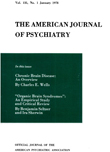CLINICAL EFFICACY OF PROCLORPERAZINE (COMPAZINE) IN MENTAL ILLNESS
Abstract
In the management of 100 hospitalized and 50 nonhospitalized emotionally disturbed patients, proclorperazine (Compazine) was judged from clinical experience to be somewhere between chlorpromazine and meprobamate in effectiveness. In some cases the degree of effectiveness was greater than by the use of chlorpromazine or meprobamate. Proclorperazine seems to have distinct advantage over chlorpromazine in that it produced much less drowsiness and lethargy. Tranquilization was achieved without sedation. There was no incident of any toxic effects and most of the disturbing side effects such as muscular rigidity, restlessness, and weakness responded quite well to Cogentin or Kemadrin.
On the negative side, however, there was a much higher incidence of turbulence and paradoxical reactions. The turbulence was overcome in most instances by rapidly increasing the drug and the paradoxical reaction disappeared a few days after discontinuance of the drug.
One very important fact was observed: proclorperazine seemed to work much better in the milder and latent psychotics and in the neurotics because it seemed to facilitate ventilation, lifted repression and aided in the reestablishment of insight. There seemed to be a mobilization of ego forces with establishment of some degree of insight which appeared to have a marked reintegrative effect on the personality which stimulated the patients to seek therapy. They were quite anxious to cooperate with a psychotherapeutic program. Chlorpromazine on the other hand seemed to facilitate the repressive forces and neutralize anxiety, and consequently, there was not enough motivation to continue and cooperate with therapy.
Proclorperazine also tended to elevate the mood, stimulate the patient, and had some therapeutic benefits in cases where depression was present An analysis of the combined group (150 patients) revealed that 91 patients or approximately 60% were made more accessible, amenable, and receptive to psychotherapy. The patients seemed relaxed, agreeable, congenial, and cooperative. Privileges were more rapidly accepted and responsibilities assumed.
The use of proclorperazine as a chemotherapeutic agent combined with psychotherapy thus expedited recovery in many cases. The drug certainly possesses the potentialities of a therapeutic resource and has a definite place as an adjunct to psychotherapy in mental illnesses.
Access content
To read the fulltext, please use one of the options below to sign in or purchase access.- Personal login
- Institutional Login
- Sign in via OpenAthens
- Register for access
-
Please login/register if you wish to pair your device and check access availability.
Not a subscriber?
PsychiatryOnline subscription options offer access to the DSM-5 library, books, journals, CME, and patient resources. This all-in-one virtual library provides psychiatrists and mental health professionals with key resources for diagnosis, treatment, research, and professional development.
Need more help? PsychiatryOnline Customer Service may be reached by emailing [email protected] or by calling 800-368-5777 (in the U.S.) or 703-907-7322 (outside the U.S.).



